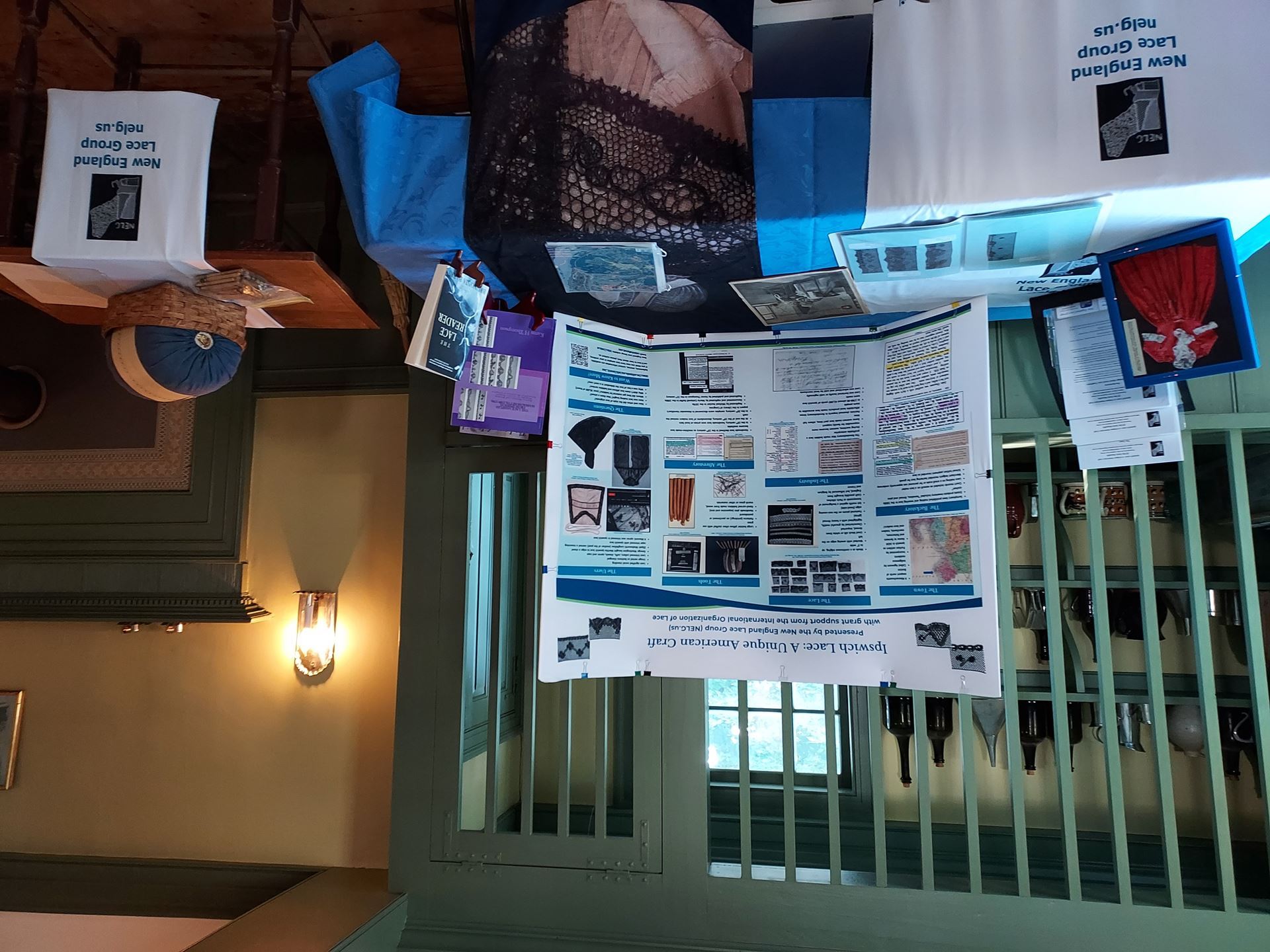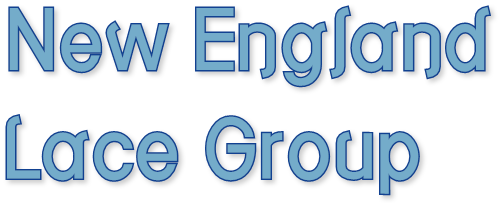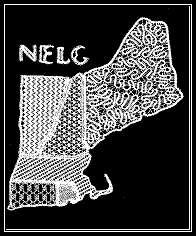Ipswich Lace: Curating a Mobile Exhibit*
Mary Mangan, Massachusetts
The COVID pandemic was a difficult period in both physical and psychological ways. For lace makers, it interrupted our typical public demonstration events as well as our regular meetings and was significantly isolating. And yet, for the New England Lace Group (NELG; USA), it spawned a project that united us and will have long-term benefits and provide future opportunities. We coordinated and trained interested NELG members, then researched and created a mobile exhibit about the historic Ipswich lace industry, thereby raising the profile of this unique textile history of our region. We succeeded beyond our own expectations and hope that this type of project can be a useful model for other lace groups.
The goal of this article is not to review the history of Ipswich lace, which you can explore elsewhere, including the Wikipedia page we help to maintain. Here we’ll explain how our NELG project came together to successfully accomplish education and outreach about our cherished local lace.
The Idea
The project began as a simple conversation at one of NELG’s outdoor demonstrations in Connecticut. NELG member Mary Linden mused to Gail MacLean that it would be cool to have an exhibit for Ipswich lace that we could bring to our public demos. On the east coast of Massachusetts, north of Boston, hundreds of people in Ipswich MA were involved in making lace in a commercial manner during the American Revolutionary War era and just beyond (circa 1750 – 1820). Although influenced by European laces, a unique style and tool kit developed in Ipswich to support American fashion at a time when importing luxury goods was challenging and decidedly un-patriotic, and supporting American production was encouraged. NELG is really well positioned to be the champions of early American lace since our region includes Ipswich, where the only known bobbin lace industry thrived in the early American Republic.
NELG Buy-in
After the initial idea, Mary and Gail brought the suggestion to our Zoom-based monthly meeting and suggested a project about Ipswich lace. The attendees were widely supportive of this idea and proposed some strategies:
- Perhaps we could create reproduction samples to show visitors to our demonstrations?
- Maybe some text-based reference materials?
Eventually, we came to the idea of a portable display that would consist of replica samples and an informational poster providing the history and research that we assembled. Generous additional donations of a replica pillow and bobbins, with some other related ephemera, would round out an exhibit table full of interesting tangible objects for an historical presentation of Ipswich lace.
Resource Acquisition
Supporting resources were needed for this concept to materialize. NELG could provide some funding, but our budget was limited during the pandemic while our typical fundraisers were impossible. Our initial work in organizing and planning the project demonstrated NELG’s support and commitment to the project, and we hoped that this would indicate to IOLI that we were serious about the work. We prepared a budget and submitted a grant proposal to the International Organization of Lace Grants Committee, under the names of IOLI members NELG President Carolyn Wetzel, Karen Thompson, and Gail MacLean. After some discussion and refinements, the proposal was favorably reviewed and the funds were awarded to us. We had everything we needed to assemble our vision.
We managed to keep the budget under $1,000, with roughly 40% underwritten by NELG and 60% by IOLI. The budget included image licensing, poster printing, a stand and clips to hold the poster, handout holders, display binders, a foldable table and tablecloth, business card printing, storage containers, and a small handcart for transport to events. We created table runners with the NELG logo and website address. We printed some images and handouts. We obtained some related books and a magazine from 1912.
We were also pleased to receive donations from people who supported this project. The Lyman Allyn Art Museum donated a banner to us that had been used in their recent exhibit about the Way sisters’ miniatures, with a terrific printing of the “Dressed Miniature” wearing Ipswich lace. Karen Thompson donated a replica pillow and bobbins, book stands, an article reprint, and copies of her book.
We found it useful to create a spreadsheet that noted items budgeted from NELG and IOLI funds and the actual costs. The same spreadsheet is used to maintain an inventory of who has possession of each exhibit item as of which date, especially helpful since our members are located throughout New England and the exhibit is intended to move from site to site. In fact, some of the exhibit items are duplicated to provide easier coverage and minimize transportation needs.
Exhibit Creation
To create the replica samples, Karen Thompson supported our effort by providing four Zoom workshops in Ipswich lace styles and techniques, attended by 24 students. It’s possible that there are now more people trained in Ipswich lace making than there have been at any time in the last 200 years! (One surprise cost: the online payments for lace classes incurred a processing fee that should have been included in our budget.)
Over 20 volunteers selected lace patterns from Karen’s book to reproduce, and all of the patterns were claimed for reproduction. Mary Linden prepared a protective book currently containing 17 of these samples for visitors to flip through. We calculated the value of these laces, based on estimated time of production and a current hourly rate, and we determined that the value of our NELG’s lace work would be in excess of a stunning $12,000 in today’s dollars.
Excerpt from sample book created by NELG members (Photo: Gail MacLean)
Although there is previous scholarship about the Ipswich laces and industry from Marta Cotterel Raffel’s and Karen Thompson’s works, we also conducted new research to enhance our information and compose our informational poster. Many New England museums and historical societies now have searchable digital archives and this work could be done remotely during the pandemic. We located text-based references to lace in New England from legal documents and court records, and found reports of prize-winning lace projects from local agricultural fairs. We identified previously uncharacterized samples of Ipswich lace on objects and belongings and negotiated licenses for image use. This research work was aided by NELG’s web team who created a members-only research and discussion forum on our website that allowed us to share information and discuss topics internally. We also used the forum for feedback on our poster construction and image selections.
We decided on two poster formats. One is a summary of key features that suits casual visitors to fiber festivals, where we have people nearby to offer additional insights and knowledge. The other is a fuller version with complete history-nerd level details and references that can stand alone in a setting like a library or historical site, for opportunities where we may not always have attendants nearby.
History-nerd level poster (PowerPoint: Mary Mangan)
Exhibit Launch
As the project matured, we had the chance to start piloting our display as post-pandemic events became possible again. Our initial “soft” opening was at the Dudley Farm Museum (Guilford CT) in June 2022, where we displayed the almost completed exhibit and learned from experience with the public what needed to be tweaked for a better product.
Our completed project was unveiled in September 2022 at a delightful opportunity in the center of our New England region. Old Sturbridge Village (Sturbridge MA), a large open-air history museum complex, offered us their Bullard Tavern for a demo and display during their popular Craft Weekend. We were very pleased to see it all come together and deliver on the promise of raising the profile of Ipswich lace in our area. We also had the chance to display at events in Guilford CT and Ogunquit ME in September and October. Guests genuinely enjoy learning something new about their region’s textile history.

Completed exhibit at Old Sturbridge Village (Photo: Mary Mangan)
Bonuses
The additional benefit of having this project underway made it easier to contact local archivists. It made introductory conversations easier. To say “I’m member of the local lace group, and we’re doing a project on Ipswich lace…” provided a level of credibility to our requests for help and information that enhanced our success. This approach also provided a useful outreach strategy to our local media. Journalists need to have some kind of novelty to develop a story, and our project offered that extra “hook” that enabled us to get a segment on a Boston NPR show’s “Hidden History” segment.
Our research led to the discovery of unidentified Ipswich lace in the collection of the Maine Historical Society. They were thrilled by the discovery and invited us to speak about our Ipswich project in their "Northern Threads" series. A recording of the presentation is available for us to share widely.
Recording of the Maine Historical Society presentation (Screen shot: Mary Mangan)
Our project became a multi-media strategy in ways we didn’t anticipate, but really appreciated.
Lessons Learned
As we continue to roll out our mobile display, we are learning about things to tweak or enhance. For example, we’d like to make text changes to the poster that we will implement in a future re-printing, such as new emphasis on the topics of the most common questions. The poster was created in PowerPoint, which is relatively easy to modify and share with each other. We’ve been very pleased with the poster that we printed on custom fabric at Spoonflower. It’s reusable at event after event, durable, and transports beautifully without wrinkling. We are also refining what kinds of take-away flyers and details that visitors are interested in, such as where to learn how to make lace and even fiction books about lace.
Another lesson learned: we found ourselves continually turning to the same items in the books we brought and realized that simply bookmarking those for quick access was a convenient aid. We are considering sturdier poster support for windy outdoor settings, and we may add or adjust different display features as we go forward.
We continue to use this project as an entry point for local historical archives and societies while we are continuing our research and seeking demonstration opportunities. We’d be very pleased to share our experiences and knowledge with any IOLI groups who want to know what has worked for us.
Concluding Thoughts
Overall, this project delivered many dividends beyond the initial goal of raising the profile of Ipswich lace in our area. It energized NELG, provided new research and knowledge on the subject, and offered a cohesive story that was more useful for wider outreach than we even imagined. We think other lace groups could have similar project ideas related to their local history, or a regional lace style that the group celebrates, or any other special topic you might adopt. There is opportunity for lace outreach that could be very effective on many fronts, supporting the mission of the International Organization of Lace, Inc., to educate and enchant the public.
Article author Mary Mangan, an avid Revolutionary War reenactor, uses Ipswich lace to make her period clothing more authentic. She thanks Ipswich lace teacher and author Karen Thompson, NELG President Carolyn Wetzel, and fellow Ipswich enthusiast Gail MacLean for their help with this article.
A PDF version of this article can be viewed here.
*Originally published in The Bulletin of the International Organization of Lace, Inc., Volume 43, Number 3/Spring 2023.

